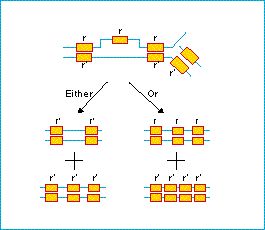Molecular and Mendelian Genetics - What is selfish DNA?

Repetitive DNA
In theory any kind of mutation could give rise to selfish DNA. For example, a point mutation could inactivate a gene, converting it into a pseudogene. However, for repetitive DNA, other kinds of mutations would be needed.
Two processes have been suggested:
1. Slippage
This occurs when one DNA strand is being created by replication from another strand. The two strands may slip relative to one another by a few nucleotides, such that either a few nucleotides are missed out, or copied twice.
2. Unequal crossing-over
This can produce a strand with a greater or lesser number of repeats, and successive rounds of unequal crossing-over can build up, or break down, long sequences of repeats.
Figure: slippage happens when a sequence of DNA is copied twice, generating a new strand with an extra copy of that sequence, or missed out, generating a new strand with one copy less. The row of repeats may therefore shrink or grow when the r and complementary r' sequences are misalinged. The molecular details are unknown, but may involve the formation of a loop. Short repeats may be particularly vulnerable to slippage.
| Next |



